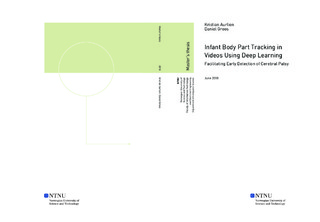Infant Body Part Tracking in Videos Using Deep Learning - Facilitating Early Detection of Cerebral Palsy
Master thesis
Permanent lenke
http://hdl.handle.net/11250/2615882Utgivelsesdato
2018Metadata
Vis full innførselSamlinger
Sammendrag
The breakthrough of Artificial Intelligence with the advent of Deep Learning has opened paths beyond what have earlier been explored. Within the medical domain, there are potentials to improve how problems are addressed and in the quality of the solutions. Computer-based methods have proven to facilitate early detection of cerebral palsy, which can make a difference by enabling treatment that can reduce the extent of disabilities in affected children. As these systems depend on motion patterns, information about the movement of infants must be collected.
In this thesis, we propose a method for tracking body parts of infants in video recordings. The developed framework addresses the task by identifying body parts frame by frame. In this way, the approach can be related to existing methods within the domain of Computer Vision, and more specifically the task of Human Pose Estimation. Taking advantage of recent progress in Deep Learning, the proposed Convolutional Neural Network outperforms existing techniques within the field, by localizing body parts of infants more precisely and at the same time operating at a speed of 120 frames per second. A large dataset of 140 700 annotated keypoints is constructed to facilitate this development. The proposed method has the potential of constituting an essential part of a system able to detect cerebral palsy at an age when the brain still has the ability to adapt.
